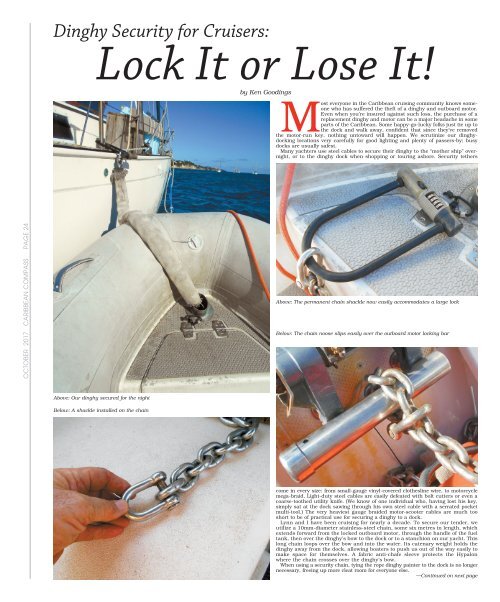Caribbean Compass Yachting Magazine October 2017
Welcome to Caribbean Compass, the most widely-read boating publication in the Caribbean! THE MOST NEWS YOU CAN USE - feature articles on cruising destinations, regattas, environment, events...
Welcome to Caribbean Compass, the most widely-read boating publication in the Caribbean! THE MOST NEWS YOU CAN USE - feature articles on cruising destinations, regattas, environment, events...
You also want an ePaper? Increase the reach of your titles
YUMPU automatically turns print PDFs into web optimized ePapers that Google loves.
Dinghy Security for Cruisers:<br />
Lock It or Lose It!<br />
by Ken Goodings<br />
Most everyone in the <strong>Caribbean</strong> cruising community knows someone<br />
who has suffered the theft of a dinghy and outboard motor.<br />
Even when you’re insured against such loss, the purchase of a<br />
replacement dinghy and motor can be a major headache in some<br />
parts of the <strong>Caribbean</strong>. Some happy-go-lucky folks just tie up to<br />
the dock and walk away, confident that since they’ve removed<br />
the motor-run key, nothing untoward will happen. We scrutinize our dinghydocking<br />
locations very carefully for good lighting and plenty of passers-by; busy<br />
docks are usually safest.<br />
Many yachters use steel cables to secure their dinghy to the “mother ship” overnight,<br />
or to the dinghy dock when shopping or touring ashore. Security tethers<br />
OCTOBER <strong>2017</strong> CARIBBEAN COMPASS PAGE 24<br />
Above: The permanent chain shackle now easily accommodates a large lock<br />
Below: The chain noose slips easily over the outboard motor locking bar<br />
Above: Our dinghy secured for the night<br />
Below: A shackle installed on the chain<br />
come in every size: from small-gauge vinyl-covered clothesline wire, to motorcycle<br />
mega-braid. Light-duty steel cables are easily defeated with bolt cutters or even a<br />
coarse-toothed utility knife. (We know of one individual who, having lost his key,<br />
simply sat at the dock sawing through his own steel cable with a serrated pocket<br />
multi-tool.) The very heaviest gauge braided motor-scooter cables are much too<br />
short to be of practical use for securing a dinghy to a dock.<br />
Lynn and I have been cruising for nearly a decade. To secure our tender, we<br />
utilize a 10mm-diameter stainless-steel chain, some six metres in length, which<br />
extends forward from the locked outboard motor, through the handle of the fuel<br />
tank, then over the dinghy’s bow to the dock or to a stanchion on our yacht. This<br />
long chain loops over the bow and into the water. Its catenary weight holds the<br />
dinghy away from the dock, allowing boaters to push us out of the way easily to<br />
make space for themselves. A fabric anti-chafe sleeve protects the Hypalon<br />
where the chain crosses over the dinghy’s bow.<br />
When using a security chain, tying the rope dinghy painter to the dock is no longer<br />
necessary, freeing up more cleat room for everyone else.<br />
—Continued on next page


















